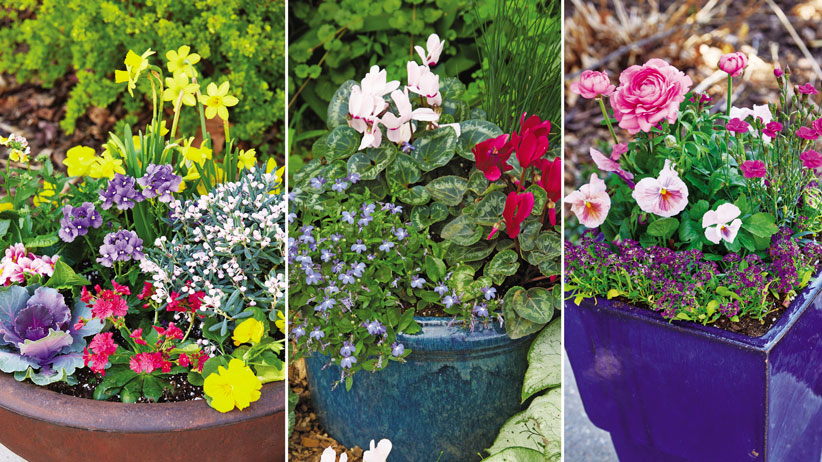Create a garden with year-round beauty
It’s easy to create a beautiful garden in May, June and July, when many perennials are at their peak. But the rest of the year can be more of a challenge. Does this mean you should give up and go inside for the other nine months? Absolutely not! You just need to pick some multiseason plants!
Multiseason plants have interesting flowers, foliage & more
Of course, the first thing most people notice about a plant is the flowers. That’s a great starting point, but don’t stop there. Many plants offer other great visuals: colorful bark, great fall foliage, a bold overall shape, appealing texture, pretty seed pods. Choose several plants that have multiple seasons of interest, and you can easily have a garden with year-round appeal even in a small space. Let’s take a look at 9 plants that’ll add pop to your garden no matter what the calendar says! Click through the slideshow below.
You Might Also Like:
Colorful Fall Garden Bed Plan
Jewel-Toned Fall Garden Ideas
Best Plants for a Foundation Planting
Helpful Gardening Videos

Bloodtwig dogwood (Cornus sanguinea Arctic Sun™ (‘Cato’))
This showstopping shrub starts out gently in the spring, with yellow-green foliage and white flowers followed by white berries in summer. In fall, yellow foliage holds on for several weeks. Then it finally falls to reveal yellow stems. The best color is on new stems, so prune out a quarter to a third of the oldest, largest stems every year in early spring to keep the winter color at its peak.
Type Shrub Blooms White in late spring Light Full sun to part shade Soil Moist, well-drained Size 3 to 4 ft. tall and wide Hardiness Cold hardy in USDA zones 4 to 8
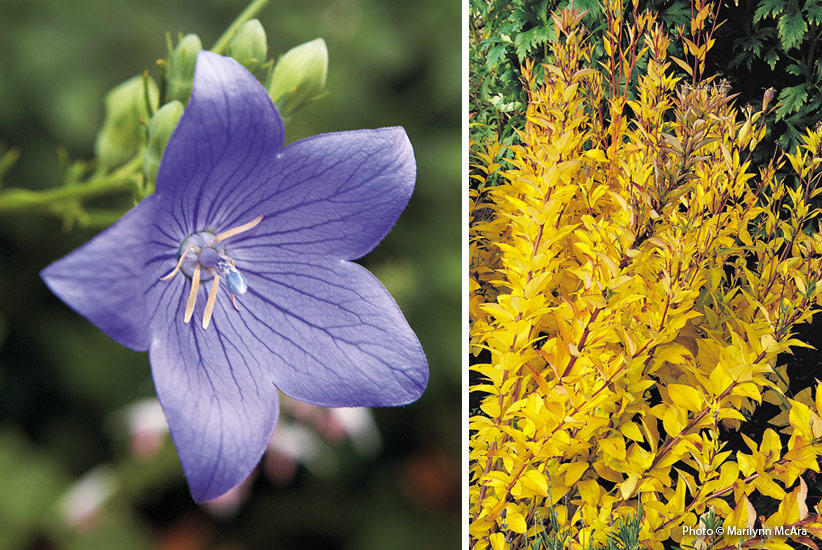
Balloon flower (Platycodon grandiflorus)
The most common color for balloon flower is blue, like ‘Mariesii’ in the photo, but you’ll also find white cultivars, such as ‘Fuji White,’ and pink ones, such as low-growing ‘Astra’. Balloon flower’s blooms last most of the summer. But did you know that the foliage turns that rich yellow in fall?
Type Perennial Blooms Blue, white or pink from early to late summer Light Full sun to part shade Soil Well-drained, slightly acid Size 6 to 48 in. tall, 12 to 18 in. wide Hardiness Cold hardy USDA zones 3 to 9
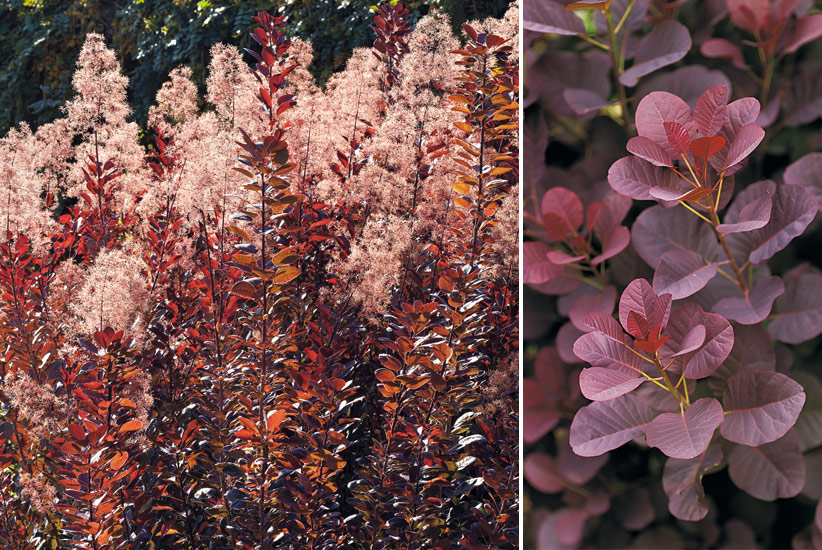
Smokebush (Cotinus coggygria)
The fluffy fibers that cover this shrub in midsummer really do look like smoke. The foliage alone is enough reason to plant smokebush. ‘Royal Purple’ in the photos has rich burgundy leaves, but Golden Spirit™ is a chartruese color. In fall, the foliage changes to shades of red and orange, with the chartreuse cultivars becoming lighter orange. Smokebush gets the best color in full sun.
Type Shrub Blooms Insignificant yellow blooms followed by tufts of purple fibers that cover the plant in midsummer Light Full sun Soil Well-drained Size 6 to 15 ft. tall and wide Hardiness Cold hardy in USDA zones 5 to 8
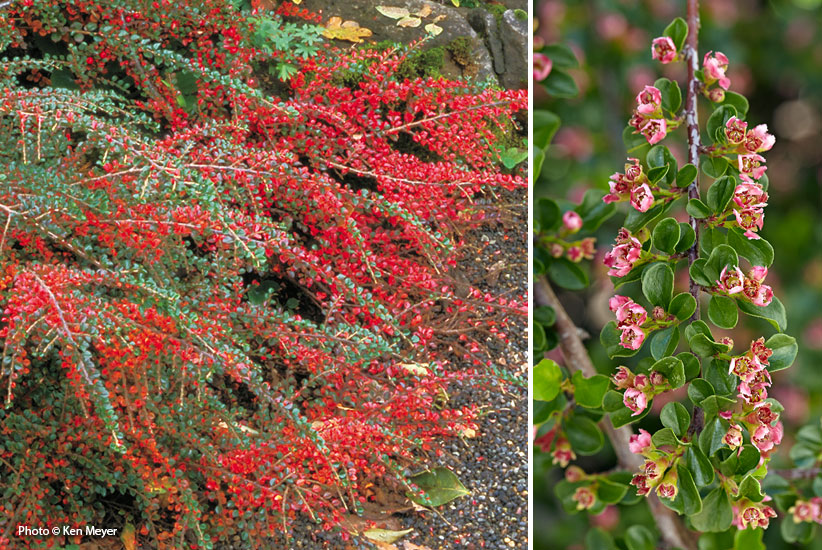
Rockspray cotoneaster (Cotoneaster horizontalis)
Arching stems with a distinctive “fishbone” twig pattern create a dense mound. Small pink flowers in late spring are followed by the masses of red fruit that hold on through winter. The leaves are semi-evergreen — in warmer climates or sheltered locations, the foliage will stay on all winter. In exposed or colder sites, you’ll see some winter dieback that requires pruning.
Type Shrub Blooms Light pink in late spring Light Full sun Soil Well-drained Size 2 to 3 ft. tall, 5 to 8 ft. wide Hardiness Cold hardy in USDA zones 4 to 7
You Might Also Like:
Fall Garden Show-Offs
Best Plants with Berries for Birds
Beautiful Hillside Garden | 2021 Reader Garden Award Winner

Siberian iris (Iris sibirica)
Whether you prefer gentle pastels or the rich purple of ‘Caesar’s Brother’ in the photo, there’s a Siberian iris for you. But it gets better: Green seed pods turn brown and remain standing all winter. The grasslike foliage turns the warm orange-yellow you can see above as the garden winds down for the year. You’ll know it’s time to divide when you see a ring of foliage around a dead center every few years.
Type Perennial Blooms Purple, blue, white, pink or yellow in late spring Light Full sun to part shade Soil Rich, moist Size 24 to 48 in. tall, 24 to 30 in. wide Hardiness Cold hardy in USDA zones 3 to 9
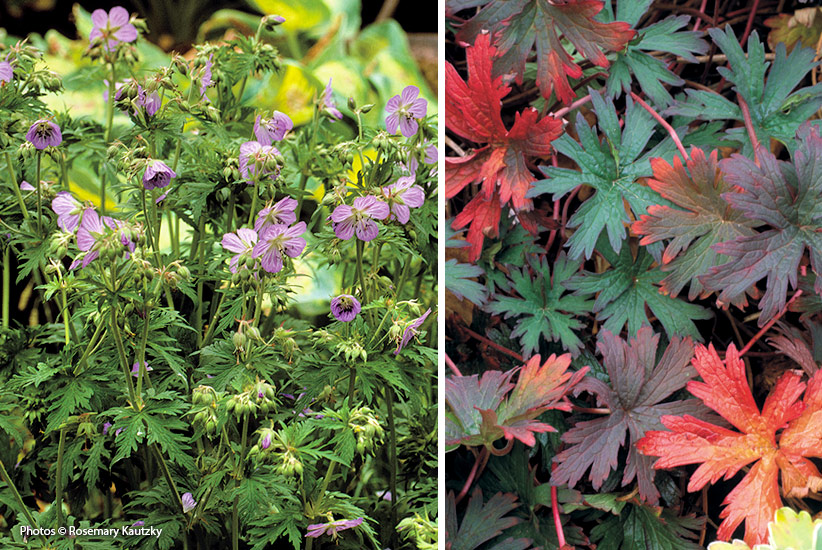
Meadow cranesbill (Geranium pratense)
Meadow cranesbill sports deeply cut leaves, and some, like the Victor Reiter Junior strain in the photo, have a purple tint to the foliage, particularly in the spring. In fall, the foliage turns, with every leaf a slightly different color. If you’re growing this perennial in very dry conditions, it may look brown by late summer, but it’ll bounce back once temperatures cool off.
Type Perennial Blooms Purple, blue or white in late spring to early summer; can rebloom Light Full sun to part shade Soil Rich, moist Size 6 to 36 in. tall, 12 to 30 in. wide Hardiness Cold hardy in USDA zones 4 to 9
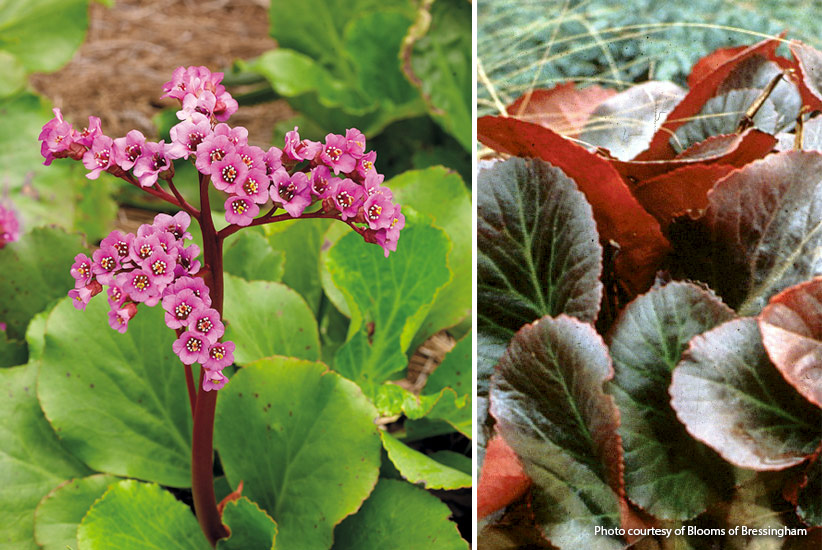
Bergenia (Bergenia cordifolia)
Spikes of pink flowers on dark stems shoot up in midspring, and the big glossy leaves look great for months. They’ll turn that gorgeous dark red (at right) in fall, and in Southern gardens, the foliage is evergreen. Cut back any ratty-looking leaves in early spring. Bergenia makes a nice ground cover, spreading slowly by rhizomes into large clumps.
Type Perennial Blooms Pink in midspring Light Part to full shade Soil Rich, moist, but tolerant of most conditions Size 8 to 24 in. tall, 12 to 24 in. wide Hardiness Cold hardy USDA zones 3 to 9

Sedum (Sedum rupestre ‘Angelina’)
New growth on ‘Angelina’ is bright yellow-green, just like you see on the left. Yellow flowers show up on the tips of the stems in midsummer, and then start to turn orange in fall! In warmer climates, this sedum is evergreen, but if you live where it dies back in the winter, trim off dead stems in early spring and wait for it to reappear.
Type Perennial Blooms Yellow in midsummer Light Full sun Soil Well-drained Size 3 to 6 in. tall, 10 to 18 in. wide Hardiness Cold hardy USDA zones 5 to 9
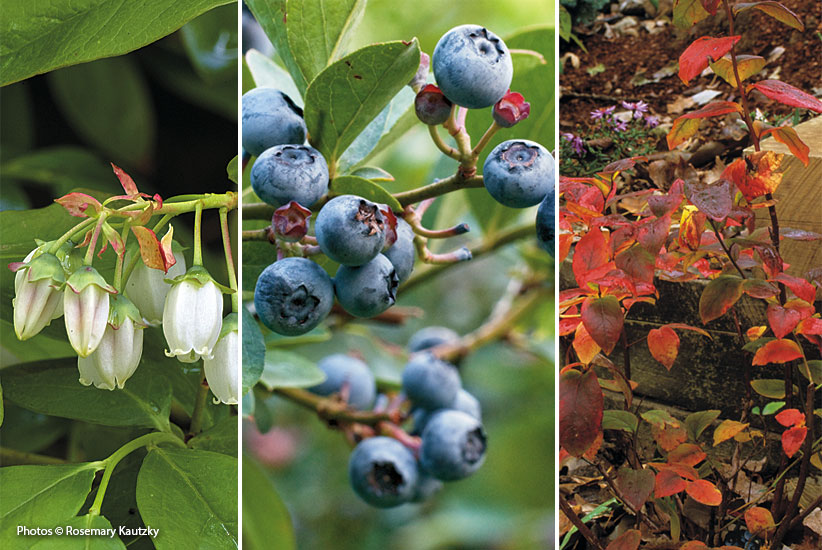
Highbush blueberry (Vaccinium corymbosum)
Clusters of the white flowers at left dangle from highbush blueberry’s stems in spring. In midsummer, the blue fruits ripen. (You’ll get more berries if you plant a couple different cultivars.) And that bright orange-red foliage color you see here lasts for weeks in fall.
Type Shrub Blooms Small white spring flowers followed by blue edible fruit Light Full sun Soil Acid, moist, well-drained Size 5 to 12 ft. tall and wide Hardiness Cold hardy USDA zones 3 to 8











